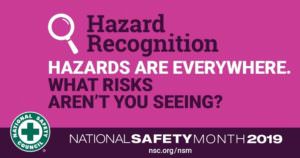
Hazards are everywhere, but sometimes it’s difficult to spot them. Oftentimes the more accustomed you are to your environment, the more blind you can become to the dangers that surround you. So how can you train yourself to spot hazards? Below are a few tips from the National Safety Council.

At Portacool, we address a variety of safety hazards on a weekly basis by emailing a weekly notation on a safety topic and suggested solutions. We also post information visibly in employee areas onsite in our manufacturing plant. Here are three potential hazards we’ve covered recently that could possibly be true for your workspaces as well.
Heat. Heat is not always an obvious hazard, but it can be a very dangerous one. Unfortunately, due to challenging work environments or heat-producing machinery, it can also be unavoidable. The key when dealing with extreme heat is to plan ahead, control what you can, and know the signs of heat-related illnesses. Heat can take a toll on employees in many different forms, including heat cramps, dehydration, or heat illness. It’s important to educate employees on the symptoms for each of these conditions so they know what to look for and when to make the decision to take a break. Heat stress and illness can be minimized with rest breaks, hydrating drinks that contain electrolytes, and physical coolers that bring down the surrounding temperature. At the Portacool plant, we use our very own evaporative coolers to spot cool workers on the assembly line and the roto-molding platforms.
Shortcuts. When we are working to get a job done, we tend to overlook the risk of getting injured. Maybe we have done the job before, and it seems almost second nature. If we haven’t been injured so far why would we get injured this time? We know the right way to do it and we think to ourselves, “it won’t happen to me.” However, shortcuts create hazards that we may not even see. That is why it is important to remain intentional and conscious of the steps you are taking every day to avoid falling victim to an error. Encourage your team to follow appropriate steps and routine measures because a failed shortcut can lead to an injury or health risk. While we all have goals and objectives to meet, it is more important that we meet them the same way we started – safe and healthy.
Non-Tangible Dangers. When it comes to safety, be on the lookout for things that you can see but don’t seem like a big deal, like a timely replacement of burnt-out bulbs. Poor lighting can cause more hazards than you may guess. It can affect your work product, limiting your vision and ability to notice details. Scraps, trash, and debris are also things that are seen but may not seem like a big deal. Aside from the aesthetic of having a clean workplace, these sorts of things can cause a tripping hazard or put employees at risk of injury. Instead of keeping hazards in the shadows, make sure to clean them up to keep yourself and those around you safe.